Performance, Emission and Combustion Characteristics of a Diesel Engine Powered by Macadamia and Grapeseed Biodiesels
Abstract
1. Introduction
2. Materials and Methods
2.1. Biodiesel Preparation
| Property Specification | Unit | Grapeseed Biodiesel | Macadamia Biodiesel | Kesambi Biodiesel [52] | Simarouba Biodiesel [53] | Mandarin Biodiesel [47] | Apricot Biodiesel [54] | Diesel | Standard Methods |
|---|---|---|---|---|---|---|---|---|---|
| Density at 15 °C | kg/m3 | 881 | 868 | 875.6 | 862 | 866 | 879.4 | 832 | ASTM D1298 |
| Viscosity at 40 °C | mm2/s | 4.13 | 4.57 | 4.71 | 3.1 | 4.10 | 4.21 | 4.10 | ASTM D445 |
| Cetane number | - | 48 | 57.5 | - | 56.8 | 44 | 49.87 | 44 | ASTM D613 |
| Calorific value | MJ/kg | 39.79 | 39.98 | 42.27 | 40.32 | 45.66 | 38.30 | 45.67 | ASTM D240 |
| Cold filter plugging point | °C | −6 | −4 | 4 | - | −7.3 | - | −3 | ASTM D6371 |
| Flash point | °C | 175 | 135 | 173 | 178 | 60 | 170 | 60 | ASTM D93 |
| Cloud point | °C | −2 | 6 | 5 | 17 | −8.6 | −4 | −8.6 | ASTM D2500 |
| Pour point | °C | −6 | −3 | 4 | 14 | −15 | −8 | −15 | ASTM D97 |
| Iodine number | g/100 g | 138 | 76.44 | - | - | 106.21 | 100.7 | - | ASTM D1959 |
| Acid value | mgKOH/g | 0.27 | 0.15 | - | 0.4 | 0.22 | 0.08 | 0.5 | ASTM D664 |
| Oxygen content | % | 11.18 | 11.71 | - | - | - | - | 0 | - |
2.2. Experimental Setup for Engine Performance and Emission Measurement
3. Results and Discussions
3.1. Engine Performance Analysis
3.1.1. Brake Power (BP)
3.1.2. Brake Specific Fuel Consumption (BSFC)
3.1.3. Brake Thermal Efficiency (BTE)
3.2. Emission Analysis
3.2.1. Carbon-Mono-Oxide (CO) Emission
3.2.2. Balancing of CO2/CO Ratio
3.2.3. Hydrocarbon (HC) Emission
3.2.4. Particulate Matters (PM) Emission
3.2.5. Nitrogen Oxide (NOx) Emission
3.3. Combustion Analysis
3.3.1. Cylinder Pressure (CP)
3.3.2. Heat Release Rate (HRR)
4. Conclusions and Recommendations
- The experimental results suggest a higher BSFC for biodiesel blends compared to that of diesel. BSFC increased by 2 to 8.5% for B5 biodiesel blend and 3 to 16% for B10 biodiesel blend. On the contrary, BP and BTE were reduced in the case of biodiesel blends when compared with diesel fuel. The reduction in BP and BTE for B5 biodiesel blend was in the range of 0.5 to 6.5% and 2 to 7%, respectively, and for B10 biodiesel blend it was 0 to 8% and 2 to 12.5%, respectively. The higher BSFC and lower BP and BTE in the case of biodiesel blends were due to the lower calorific value of biodiesel than diesel fuel.
- The use of biodiesel blends in a diesel engine exhibited better emissions profile compared to diesel, particularly in the case of CO, the ratio of CO2/CO, HC and PM emissions. It was observed that CO, CO2/CO ratio, HC and PM emissions were significantly reduced when B5 and B10 biodiesel blends of Macadamia and Grapeseed biodiesel were used in the diesel engine instead of diesel only. The findings were also verified by conducting the t-test analysis. However, the increase in NOx emission was observed for all biodiesel blends.
- The variation in-cylinder pressure and heat release rate with the crank angle for all the biodiesel blends was nearly the same as that of diesel fuel. Only a slight increase in-cylinder pressure was observed for Macadamia biodiesel blends B10 and B5 at a crank angle from 355 °CA to 375 °CA.
Author Contributions
Funding
Conflicts of Interest
References
- Azad, A.; Rasul, M.; Khan, M.; Omri, A.; Bhuiya, M.; Ali, M. Modelling of renewable energy economy in Australia. Energy Proc. 2014, 61, 1902–1906. [Google Scholar] [CrossRef][Green Version]
- Hassan, N.M.; Rasul, M.; Harch, C. Modelling and experimental investigation of engine performance and emissions fuelled with biodiesel produced from Australian Beauty Leaf Tree. Fuel 2015, 150, 625–635. [Google Scholar] [CrossRef]
- Lin, B.-J.; Chen, W.-H.; Hsieh, T.-H.; Ong, H.C.; Show, P.L.; Naqvi, S.R. Oxidative reaction interaction and synergistic index of emulsified pyrolysis bio-oil/diesel fuels. Renew. Energy 2019, 136, 223–234. [Google Scholar] [CrossRef]
- Demirbas, A. Progress and recent trends in biodiesel fuels. Energy Convers. Manag. 2009, 50, 14–34. [Google Scholar] [CrossRef]
- Tahir, M.H.; Zhao, Z.; Ren, J.; Rasool, T.; Naqvi, S.R. Thermo-kinetics and gaseous product analysis of banana peel pyrolysis for its bioenergy potential. Biomass Bioenergy 2019, 122, 193–201. [Google Scholar] [CrossRef]
- Reza Miri, S.M.; Mousavi Seyedi, S.R.; Ghobadian, B. Effects of biodiesel fuel synthesized from non-edible rapeseed oil on performance and emission variables of diesel engines. J. Clean. Prod. 2017, 142, 3798–3808. [Google Scholar] [CrossRef]
- Halder, P.; Azad, K.; Shah, S.; Sarker, E. Prospects and technological advancement of cellulosic bioethanol ecofuel production. In Advances in Eco-Fuels for a Sustainable Environment; Azad, K., Ed.; Woodhead Publishing: Cambridge, UK, 2019; pp. 211–236. [Google Scholar]
- Naqvi, S.R.; Naqvi, M.; Noor, T.; Hussain, A.; Iqbal, N.; Uemura, Y.; Nishiyama, N. Catalytic Pyrolysis of Botryococcus Braunii (microalgae) Over Layered and Delaminated Zeolites for Aromatic Hydrocarbon Production. Energy Proc. 2017, 142, 381–385. [Google Scholar] [CrossRef]
- Azad, A.K.; Rasul, M.G.; Khan, M.M.K.; Sharma, S.C.; Mofijur, M.; Bhuiya, M.M.K. Prospects, feedstocks and challenges of biodiesel production from beauty leaf oil and castor oil: A nonedible oil sources in Australia. Renew. Sustain. Energy Rev. 2016, 61, 302–318. [Google Scholar] [CrossRef]
- Bhuiya, M.; Rasul, M.; Khan, M.; Ashwath, N.; Azad, A.; Mofijur, M. Optimisation of oil extraction process from Australian native beauty leaf seed (Calophyllum inophyllum). Energy Proc. 2015, 75, 56–61. [Google Scholar] [CrossRef]
- Azad, A.K.; Rasul, M.G.; Khan, M.M.K.; Sharma, S.C.; Islam, R. Prospect of Moringa seed oil as a sustainable biodiesel fuel in Australia: A review. Proc. Eng. 2015, 105, 601–606. [Google Scholar] [CrossRef]
- Halder, P.; Azad, A.K. Chapter 7—Recent trends and challenges of algal biofuel conversion technologies. In Advanced Biofuels; Azad, A.K., Rasul, M., Eds.; Woodhead Publishing: Cambridge, UK, 2019; pp. 167–179. [Google Scholar]
- Ashok, B.; Nanthagopal, K.; Saravanan, B.; Azad, K.; Patel, D.; Sudarshan, B.; Aaditya Ramasamy, R. Study on isobutanol and Calophyllum inophyllum biodiesel as a partial replacement in CI engine applications. Fuel 2019, 235, 984–994. [Google Scholar] [CrossRef]
- Rahman, M.M.; Rasul, M.G.; Hassan, N.M.S.; Azad, A.K.; Uddin, M.N. Research, Effect of small proportion of butanol additive on the performance, emission, and combustion of Australian native first-and second-generation biodiesel in a diesel engine. Environ. Sci. Pollut. Res. 2017, 24, 22402–22413. [Google Scholar] [CrossRef] [PubMed]
- Sanjid, A.; Masjuki, H.H.; Kalam, M.A.; Rahman, S.M.A.; Abedin, M.J.; Palash, S.M. Production of palm and jatropha based biodiesel and investigation of palm-jatropha combined blend properties, performance, exhaust emission and noise in an unmodified diesel engine. J. Clean. Prod. 2014, 65, 295–303. [Google Scholar] [CrossRef]
- Chhetri, A.; Tango, M.; Budge, S.; Watts, K.; Islam, M.J.I.J.o.M.S. Non-edible plant oils as new sources for biodiesel production. Int. J. Mol. Sci. 2008, 9, 169–180. [Google Scholar] [CrossRef]
- Knothe, G.; Razon, L.F. Biodiesel fuels. Progress Energy Combust. Sci. 2017, 58, 36–59. [Google Scholar] [CrossRef]
- Azad, A.K.; Rasul, M.G.; Khan, M.M.K.; Sharma, S.C.; Hazrat, M.A. Prospect of biofuels as an alternative transport fuel in Australia. Renew. Sustain. Energy Rev. 2015, 43, 331–351. [Google Scholar] [CrossRef]
- Azad, K.; Rasul, M.G.; Khan, M.M.K.; Sharma, S.C. Introduction to sustainable and alternative ecofuels. In Advances in Eco-Fuels for a Sustainable Environment; Azad, K., Ed.; Woodhead Publishing: Cambridge, UK, 2019; pp. 1–14. [Google Scholar]
- Azad, A.K.; Rasul, M.G.; Bhuiya, M.G.; Islam, R. Effect of first and second generation biodiesel blends on engine performance and emission. AIP Conf. Proc. 2016, 1754, 050031. [Google Scholar]
- Abhilash, P.; Srivastava, P.; Jamil, S.; Singh, N. Revisited Jatropha curcas as an oil plant of multiple benefits: Critical research needs and prospects for the future. Environ. Sci. Pollut. Res. 2011, 18, 127–131. [Google Scholar] [CrossRef]
- Atabani, A.; Silitonga, A.; Ong, H.; Mahlia, T.; Masjuki, H.; Badruddin, I.A.; Fayaz, H.J.R. Non-edible vegetable oils: A critical evaluation of oil extraction, fatty acid compositions, biodiesel production, characteristics, engine performance and emissions production. Renew. Sustain. Energy Rev. 2013, 18, 211–245. [Google Scholar] [CrossRef]
- Kumar, A.; Patil, N.; Kumar, R.; Mandal, D. Irrigation scheduling and fertilization improves production potential of Jatropha (Jatropha curcas L.). A review. Int. J. Curr. Microbiol. App. Sci. 2016, 6, 1703–1716. [Google Scholar] [CrossRef]
- Ashok, B.; Saravanan, B.; Nanthagopal, K.; Azad, A.K. Chapter 11—Investigation on the effect of butanol isomers with gasoline on spark ignition engine characteristics. In Advanced Biofuels; Azad, A.K., Rasul, M., Eds.; Woodhead Publishing: Cambridge, UK, 2019; pp. 265–289. [Google Scholar]
- Ali, O.M.; Mamat, R.; Abdullah, N.R.; Abdullah, A.A. Analysis of blended fuel properties and engine performance with palm biodiesel–diesel blended fuel. Renew. Energy 2016, 86, 59–67. [Google Scholar] [CrossRef]
- Nisar, J.; Razaq, R.; Farooq, M.; Iqbal, M.; Khan, R.A.; Sayed, M.; Shah, A.; Rahman, I. Enhanced biodiesel production from Jatropha oil using calcined waste animal bones as catalyst. Renew. Energy 2017, 101, 111–119. [Google Scholar] [CrossRef]
- Eloka-Eboka, A.C.; Inambao, F.L. Hybridization of feedstocks—A new approach in biodiesel development: A case of Moringa and Jatropha seed oils. Energy Sources Part A Recovery Util. Environ. Effects 2016, 38, 1495–1502. [Google Scholar] [CrossRef]
- Agarwal, A.K. Biofuels (alcohols and biodiesel) applications as fuels for internal combustion engines. Progress Energy Combust. Sci. 2007, 33, 233–271. [Google Scholar] [CrossRef]
- Sahoo, P.; Das, L.; Babu, M.; Arora, P.; Singh, V.; Kumar, N.; Varyani, T. Comparative evaluation of performance and emission characteristics of jatropha, karanja and polanga based biodiesel as fuel in a tractor engine. Fuel 2009, 88, 1698–1707. [Google Scholar] [CrossRef]
- Sahoo, P.; Das, L. Combustion analysis of Jatropha, Karanja and Polanga based biodiesel as fuel in a diesel engine. Fuel 2009, 88, 994–999. [Google Scholar] [CrossRef]
- Dhar, A.; Kevin, R.; Agarwal, A.K. Production of biodiesel from high-FFA neem oil and its performance, emission and combustion characterization in a single cylinder DICI engine. Fuel Proces. Technol. 2012, 97, 118–129. [Google Scholar] [CrossRef]
- Nalgundwar, A.; Paul, B.; Sharma, S.K. Comparison of performance and emissions characteristics of DI CI engine fueled with dual biodiesel blends of palm and jatropha. Fuel 2016, 173, 172–179. [Google Scholar] [CrossRef]
- Patel, S.; Azad, A.K.; Khan, M. Numerical investigation for predicting diesel engine performance and emission using different fuels. Energy Proc. 2019, 160, 834–841. [Google Scholar] [CrossRef]
- Atadashi, I.M.; Aroua, M.K.; Abdul Aziz, A.R.; Sulaiman, N.M.N. Production of biodiesel using high free fatty acid feedstocks. Renew. Sustain. Energy Rev. 2012, 16, 3275–3285. [Google Scholar] [CrossRef]
- Azad, A.K.; Rasul, M.G.; Khan, M.M.K.; Sharma, S.C.; Bhuiya, M.M.K.; Mofijur, M. A review on socio-economic aspects of sustainable biofuels. Int. J. Glob. Warm. 2016, 10, 32–54. [Google Scholar] [CrossRef]
- Azad, A.K.; Rasul, M.G.; Khan, M.M.K.; Sharma, S.C.; Bhuiya, M.M.K. Study on Australian energy policy, socio-economic, and environment issues. J. Renew. Sustain. Energy 2015, 7, 063131. [Google Scholar] [CrossRef]
- Venkatesan, H.; Sivamani, S. Evaluating the predicting capability of response surface methodology on biodiesel production from grapeseed bio-oil. Energy Sources Part A Recovery Util. Environ. Effects 2019, 1–16. [Google Scholar] [CrossRef]
- Chelladorai, P.; Varuvel, E.G.; Martin, L.J.; Bedhannan, N. Synergistic effect of hydrogen induction with biofuel obtained from winery waste (grapeseed oil) for CI engine application. Int. J. Hydrogen Energy 2018, 43, 12473–12490. [Google Scholar] [CrossRef]
- Vedagiri, P.; Martin, L.J.; Varuvel, E.G. Characterization study on performance, combustion and emission of nano additive blends of grapeseed oil methyl ester fuelled CI engine with various piston bowl geometries. Heat Mass Transf. 2020, 56, 715–726. [Google Scholar] [CrossRef]
- Vedagiri, P.; Martin, L.J.; Varuvel, E.G.; Subramanian, T. Experimental study on NOx reduction in a grapeseed oil biodiesel-fueled CI engine using nanoemulsions and SCR retrofitment. Environ. Sci. Pollut. Res. 2019, 1–14. [Google Scholar] [CrossRef]
- Praveena, V.; Leenus Jesu Martin, M.; Edwin Geo, V. Effect of EGR on emissions of a modified DI compression ignition engine energized with nanoemulsive blends of grapeseed biodiesel. Fuel 2020, 267, 117317. [Google Scholar] [CrossRef]
- Bhuiya, M.M.K.; Rasul, M.G.; Khan, M.M.K.; Ashwath, N.; Azad, A.K. Prospects of 2nd generation biodiesel as a sustainable fuel—Part: 1 selection of feedstocks, oil extraction techniques and conversion technologies. Renew. Sustain. Energy Rev. 2016, 55, 1109–1128. [Google Scholar] [CrossRef]
- Barnwal, B.K.; Sharma, M.P. Prospects of biodiesel production from vegetable oils in India. Renew. Sustain. Energy Rev. 2005, 9, 363–378. [Google Scholar] [CrossRef]
- Azad, A.K.; Rasul, M.G.; Khan, M.M.K.; Sharma, S.C. Biodiesel from Queensland Bush Nut (Macadamia integrifolia). In Clean Energy for Sustainable Development; Rasul, M.G., Azad, A.k., Sharma, S.C., Eds.; Academic Press: Cambridge, MA, USA, 2017; pp. 419–439. [Google Scholar]
- Knothe, G.J.E. Biodiesel derived from a model oil enriched in palmitoleic acid, macadamia nut oil. Energy Fuels 2010, 24, 2098–2103. [Google Scholar] [CrossRef]
- Nabi, M.N.; Rasul, M.G. Influence of second generation biodiesel on engine performance, emissions, energy and exergy parameters. Energy Conv. Manag. 2018, 169, 326–333. [Google Scholar] [CrossRef]
- Azad, A. Biodiesel from mandarin seed oil: A surprising source of alternative fuel. Energies 2017, 10, 1689. [Google Scholar] [CrossRef]
- Azad, A.K.; Rasul, M.G.; Bhatt, C. Combustion and emission analysis of Jojoba biodiesel to assess its suitability as an alternative to diesel fuel. Energy Proc. 2019, 156, 159–165. [Google Scholar] [CrossRef]
- Karthickeyana, V.; Thiyagarajan, S.; Ashok, B.; Edwin Geo, V.; Azad, A.K. Experimental investigation of pomegranate oil methyl ester in ceramic coated engine at different operating condition in direct injection diesel engine with energy and exergy analysis. Energy Conv. Manag. 2020, 205, 112334. [Google Scholar] [CrossRef]
- Azad, K.; Rasul, M.G.; Khan, M.M.K.; Sharma, S.C. 12—Ecofuel and its compatibility with different automotive metals to assess diesel engine durability. In Advances in Eco-Fuels for a Sustainable Environment; Azad, K., Ed.; Woodhead Publishing: Cambridge, UK, 2019; pp. 337–351. [Google Scholar]
- Azad, A.K.; Rasul, M.G.; Sharma, S.C.; Khan, M.M.K.J.E. The Lubricity of Ternary Fuel Mixture Blends as a Way to Assess Diesel Engine Durability. Energies 2018, 11, 33. [Google Scholar] [CrossRef]
- Ong, H.C.; Mofijur, M.; Silitonga, A.; Gumilang, D.; Kusumo, F.; Mahlia, T. Physicochemical Properties of Biodiesel Synthesised from Grape Seed, Philippine Tung, Kesambi, and Palm Oils. Energies 2020, 13, 1319. [Google Scholar] [CrossRef]
- Jeyalakshmi, P. Characterization of Simarouba glauca seed oil biodiesel. J. Therm. Anal. Calorim. 2019, 136, 267–280. [Google Scholar] [CrossRef]
- Fadhil, A.B. Evaluation of apricot (Prunus armeniaca L.) seed kernel as a potential feedstock for the production of liquid bio-fuels and activated carbons. Energy Convers. Man. 2017, 133, 307–317. [Google Scholar] [CrossRef]
- Ong, H.C.; Masjuki, H.H.; Mahlia, T.M.I.; Silitonga, A.S.; Chong, W.T.; Yusaf, T. Engine performance and emissions using Jatropha curcas, Ceiba pentandra and Calophyllum inophyllum biodiesel in a CI diesel engine. Energy 2014, 69, 427–445. [Google Scholar] [CrossRef]
- An, H.; Yang, W.M.; Maghbouli, A.; Li, J.; Chou, S.K.; Chua, K.J. Performance, combustion and emission characteristics of biodiesel derived from waste cooking oils. Appl. Energy 2013, 112, 493–499. [Google Scholar] [CrossRef]
- Wan Ghazali, W.N.M.; Mamat, R.; Masjuki, H.H.; Najafi, G. Effects of biodiesel from different feedstocks on engine performance and emissions: A review. Renew. Sustain. Energy Rev. 2015, 51, 585–602. [Google Scholar] [CrossRef]
- Azad, A.K.; Rasul, M.G.; Giannangelo, B.; Ahmed, S.F. Diesel Engine Performance and Emission Study Using Soybean Biodiesel Blends with Fossil Diesel. In Exergy for A Better Environment and Improved Sustainability 2: Applications; Aloui, F., Dincer, I., Eds.; Springer International Publishing: Cham, Switzerland, 2018; pp. 137–155. [Google Scholar]
- Azad, A.K.; Rasul, M.; Khan, M.M.; Sharma, S.C. Macadamia Biodiesel as a Sustainable and Alternative Transport Fuel in Australia. Energy Proc. 2017, 110, 543–548. [Google Scholar] [CrossRef]
- Knothe, G. A comprehensive evaluation of the cetane numbers of fatty acid methyl esters. Fuel 2014, 119, 6–13. [Google Scholar] [CrossRef]
- Azad, K.; Rasul, M. Performance and combustion analysis of diesel engine fueled with grape seed and waste cooking biodiesel. Energy Proc. 2019, 160, 340–347. [Google Scholar] [CrossRef]
- Uddin, S.M.A.; Azad, A.K.; Alam, M.M.; Ahamed, J.U. Performance of a diesel engine run with mustard-kerosene blends. Proc. Eng. 2015, 105, 698–704. [Google Scholar] [CrossRef]
- Srivastava, P.K.; Verma, M. Methyl ester of karanja oil as an alternative renewable source energy. Fuel 2008, 87, 1673–1677. [Google Scholar] [CrossRef]
- Yesilyurt, M.K.; Aydin, M. Experimental investigation on the performance, combustion and exhaust emission characteristics of a compression-ignition engine fueled with cottonseed oil biodiesel/diethyl ether/diesel fuel blends. Energy Convers. Manag. 2020, 205, 112355. [Google Scholar] [CrossRef]
- Abed, K.A.; Gad, M.S.; El Morsi, A.K.; Sayed, M.M.; Elyazeed, S.A. Effect of biodiesel fuels on diesel engine emissions. Egypt. J. Pet. 2019, 28, 183–188. [Google Scholar] [CrossRef]
- Zhihao, M.; Xiaoyu, Z.; Junfa, D.; Xin, W.; Bin, X.; Jian, W. Study on Emissions of a DI Diesel Engine Fuelled with Pistacia Chinensis Bunge Seed Biodiesel-Diesel Blends. Proc. Environ. Sci. 2011, 11, 1078–1083. [Google Scholar] [CrossRef][Green Version]
- Wang, S.; Viswanathan, K.; Esakkimuthu, S.; Azad, K. Experimental investigation of high alcohol low viscous renewable fuel in DI diesel engine. Environ. Sci. Pollut. Res. 2020, 15. [Google Scholar] [CrossRef]
- Rajak, U.; Nashine, P.; Verma, T.N. Effect of spirulina microalgae biodiesel enriched with diesel fuel on performance and emission characteristics of CI engine. Fuel 2020, 268, 117305. [Google Scholar] [CrossRef]
- Bhuiya, M.M.K.; Rasul, M.G.; Khan, M.M.K.; Ashwath, N.; Azad, A.K.; Hazrat, M.A. Prospects of 2nd generation biodiesel as a sustainable fuel–Part 2: Properties, performance and emission characteristics. Renew. Sustain. Energy Rev. 2016, 55, 1129–1146. [Google Scholar] [CrossRef]
- Rashed, M.; Kalam, M.; Masjuki, H.; Habibullah, M.; Imdadul, H.; Shahin, M.; Rahman, M.J.I.c. Improving oxidation stability and NOX reduction of biodiesel blends using aromatic and synthetic antioxidant in a light duty diesel engine. Ind. Crops Prod. 2016, 89, 273–284. [Google Scholar] [CrossRef]
- Li, L.; Wang, J.; Wang, Z.; Xiao, J. Combustion and emission characteristics of diesel engine fueled with diesel/biodiesel/pentanol fuel blends. Fuel 2015, 156, 211–218. [Google Scholar] [CrossRef]
- Karthickeyan, V.; Thiyagarajan, S.; Geo, V.E.; Ashok, B.; Nanthagopal, K.; Chyuan, O.H.; Vignesh, R. Simultaneous reduction of NOx and smoke emissions with low viscous biofuel in low heat rejection engine using selective catalytic reduction technique. Fuel 2019, 255, 115854. [Google Scholar] [CrossRef]
- Gürü, M.; Koca, A.; Can, Ö.; Çınar, C.; Şahin, F. Biodiesel production from waste chicken fat based sources and evaluation with Mg based additive in a diesel engine. Renew. Energy 2010, 35, 637–643. [Google Scholar] [CrossRef]
- Rakopoulos, C.D.; Antonopoulos, K.A.; Rakopoulos, D.C. Multi-zone modeling of Diesel engine fuel spray development with vegetable oil, bio-diesel or Diesel fuels. Energy Convers. Manag. 2006, 47, 1550–1573. [Google Scholar] [CrossRef]
- Azad, A.K.; Halder, P.; Nanthagopal, K.; Ashok, B. Chapter 13—Investigation of diesel engine in cylinder flow phenomena using CFD cold flow simulation. In Advanced Biofuels; Azad, A.K., Rasul, M., Eds.; Woodhead Publishing: Cambridge, UK, 2019; pp. 329–336. [Google Scholar]
- Karthickeyan, V.; Ashok, B.; Nanthagopal, K.; Thiyagarajan, S.; Geo, V.E. Investigation of novel Pistacia khinjuk biodiesel in DI diesel engine with post combustion capture system. Appl. Therm. Eng. 2019, 159, 113969. [Google Scholar] [CrossRef]
- Azad, A.K.; Rasul, M.G.; Khan, M.M.K.; Sharma, S.C.; Bhuiya, M.M.K. Recent development of biodiesel combustion strategies and modelling for compression ignition engines. Renew. Sustain. Energy Rev. 2016, 56, 1068–1086. [Google Scholar] [CrossRef]
- Karthickeyan, V. Effect of combustion chamber bowl geometry modification on engine performance, combustion and emission characteristics of biodiesel fuelled diesel engine with its energy and exergy analysis. Energy 2019, 176, 830–852. [Google Scholar] [CrossRef]
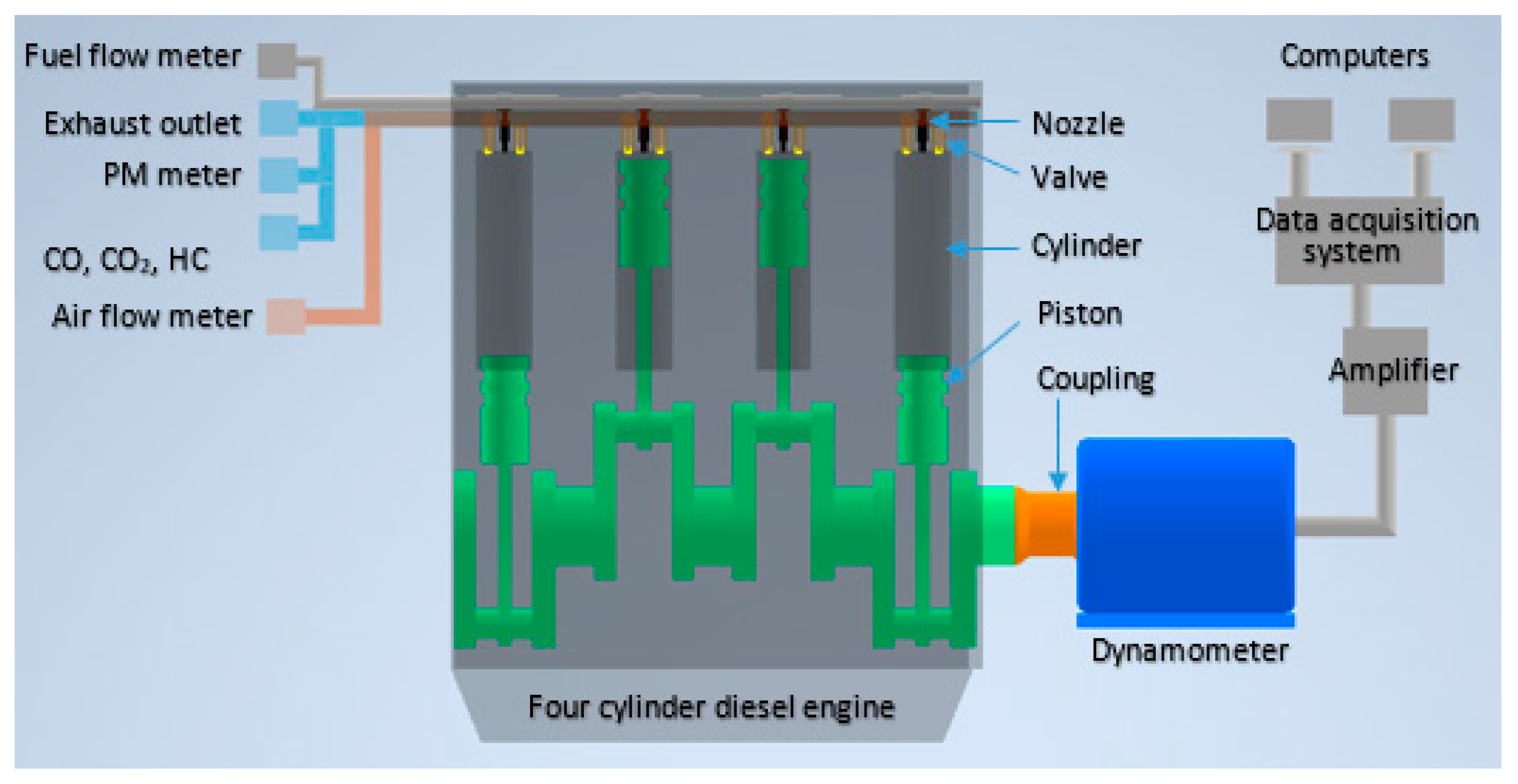
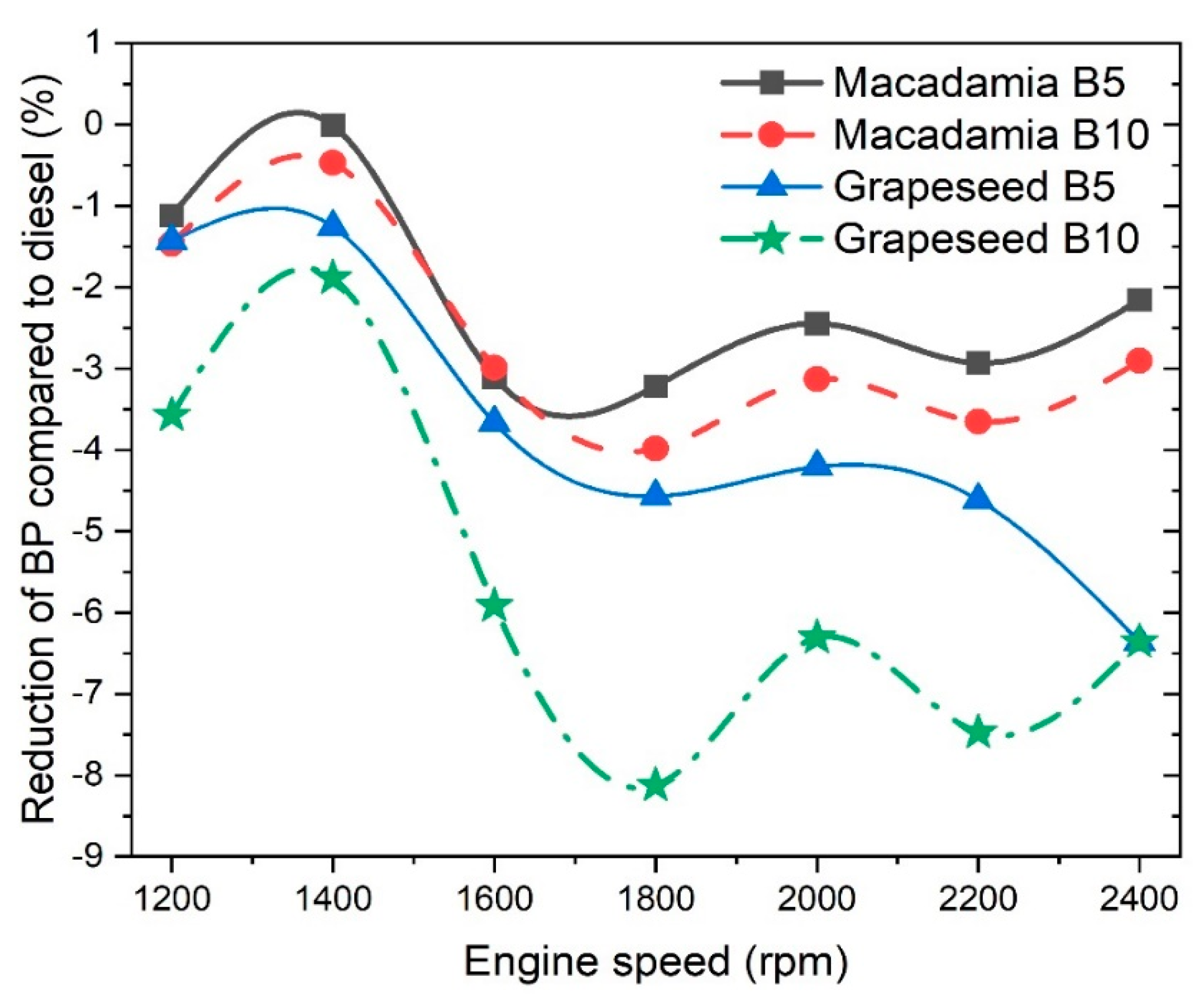
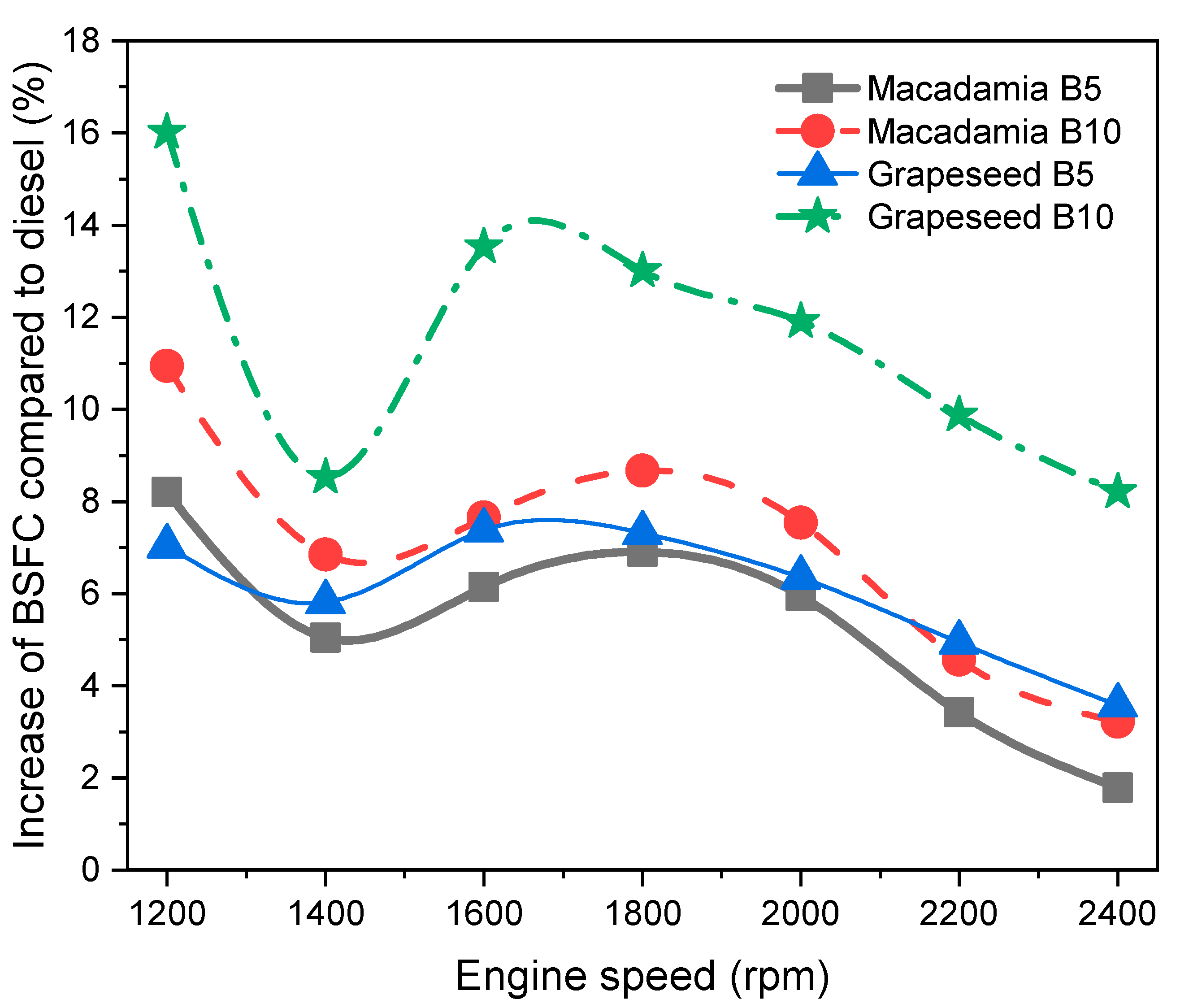


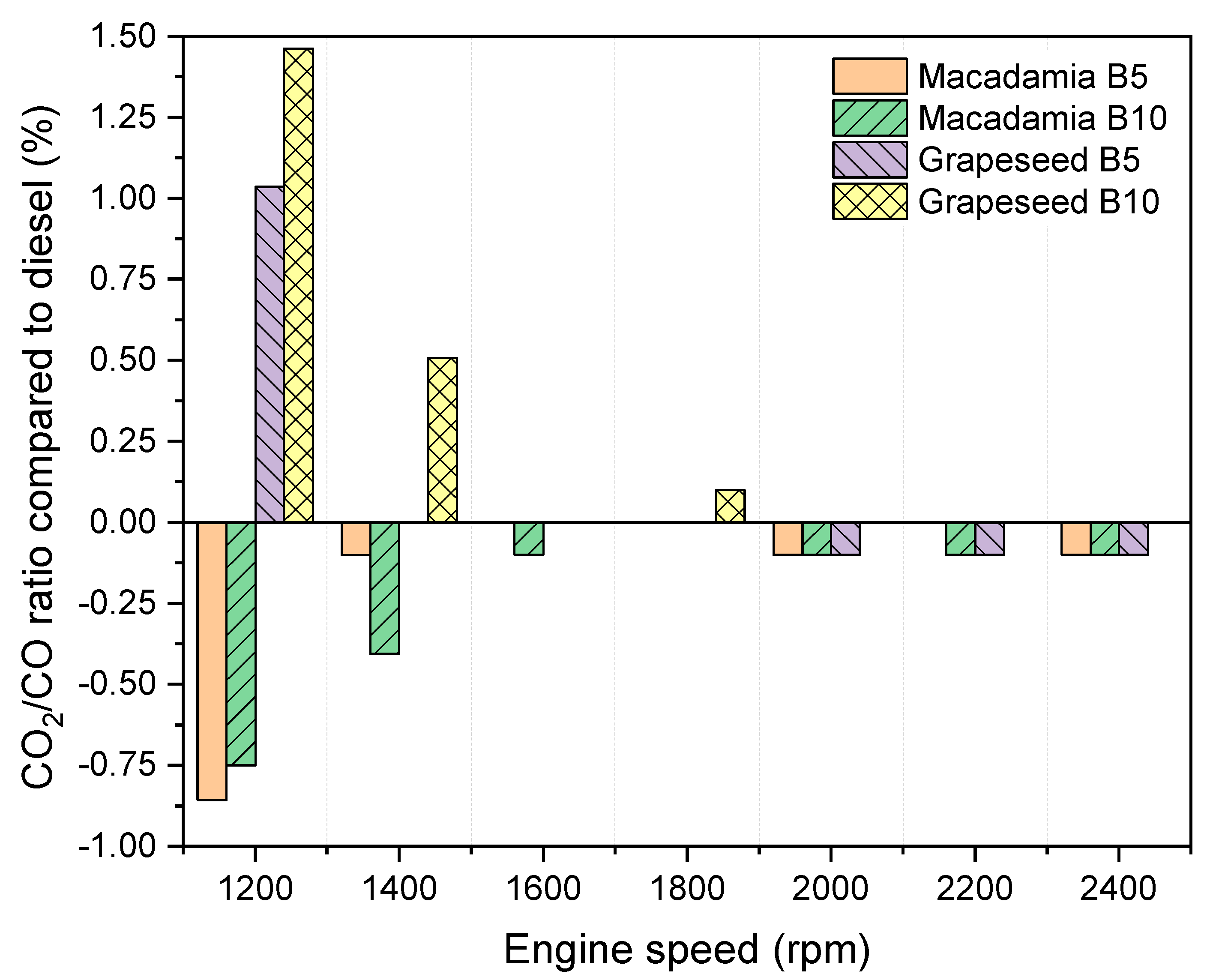
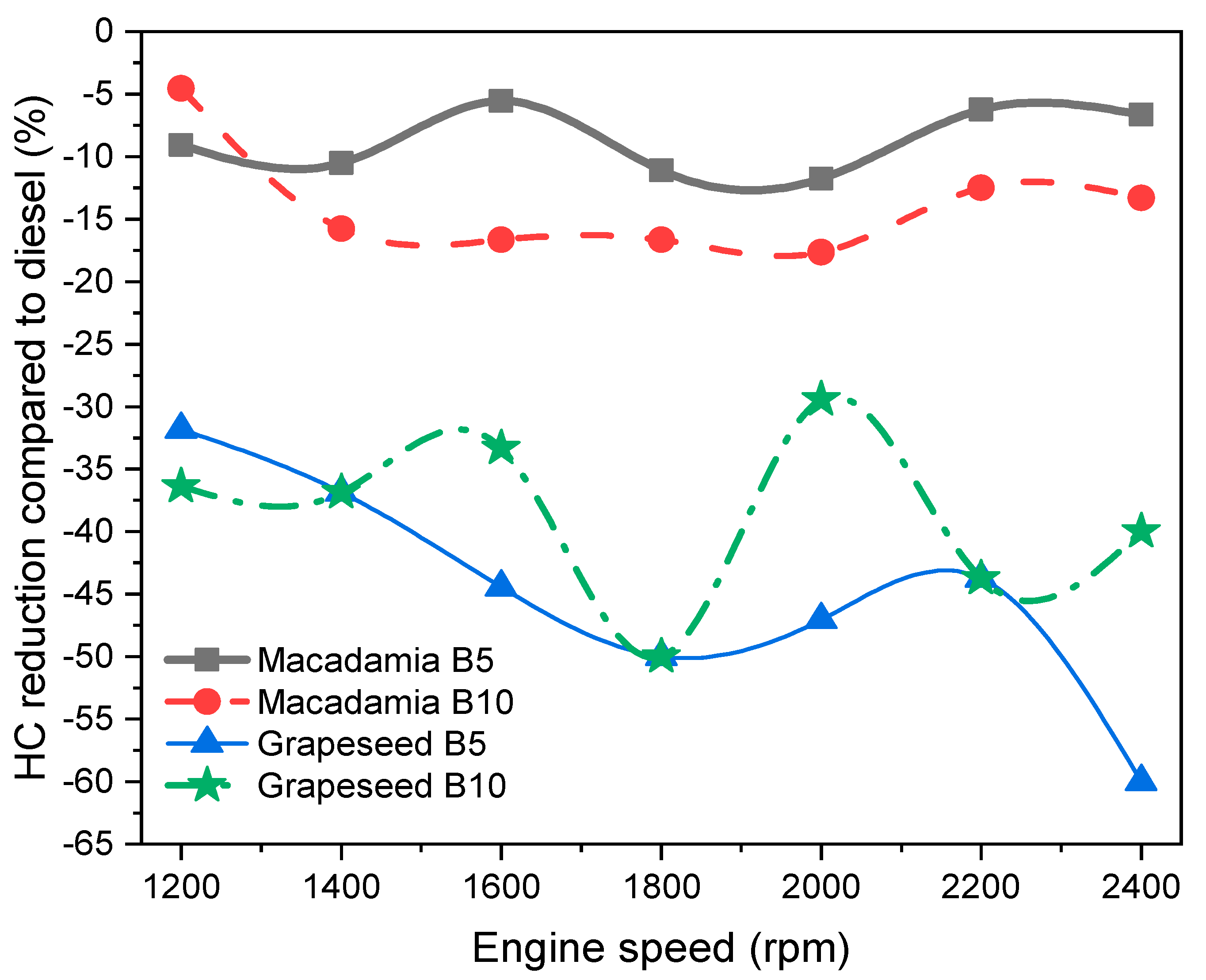
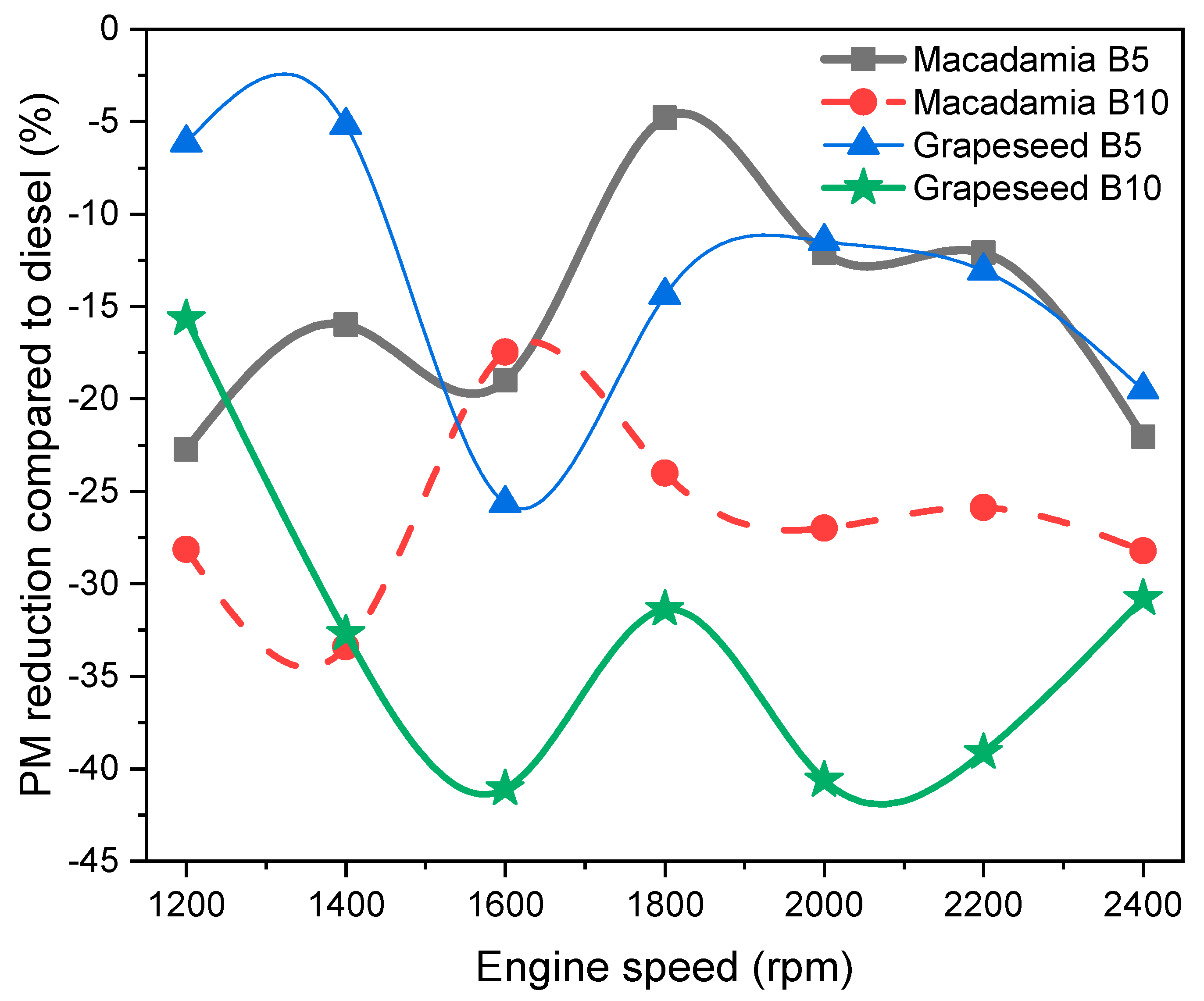
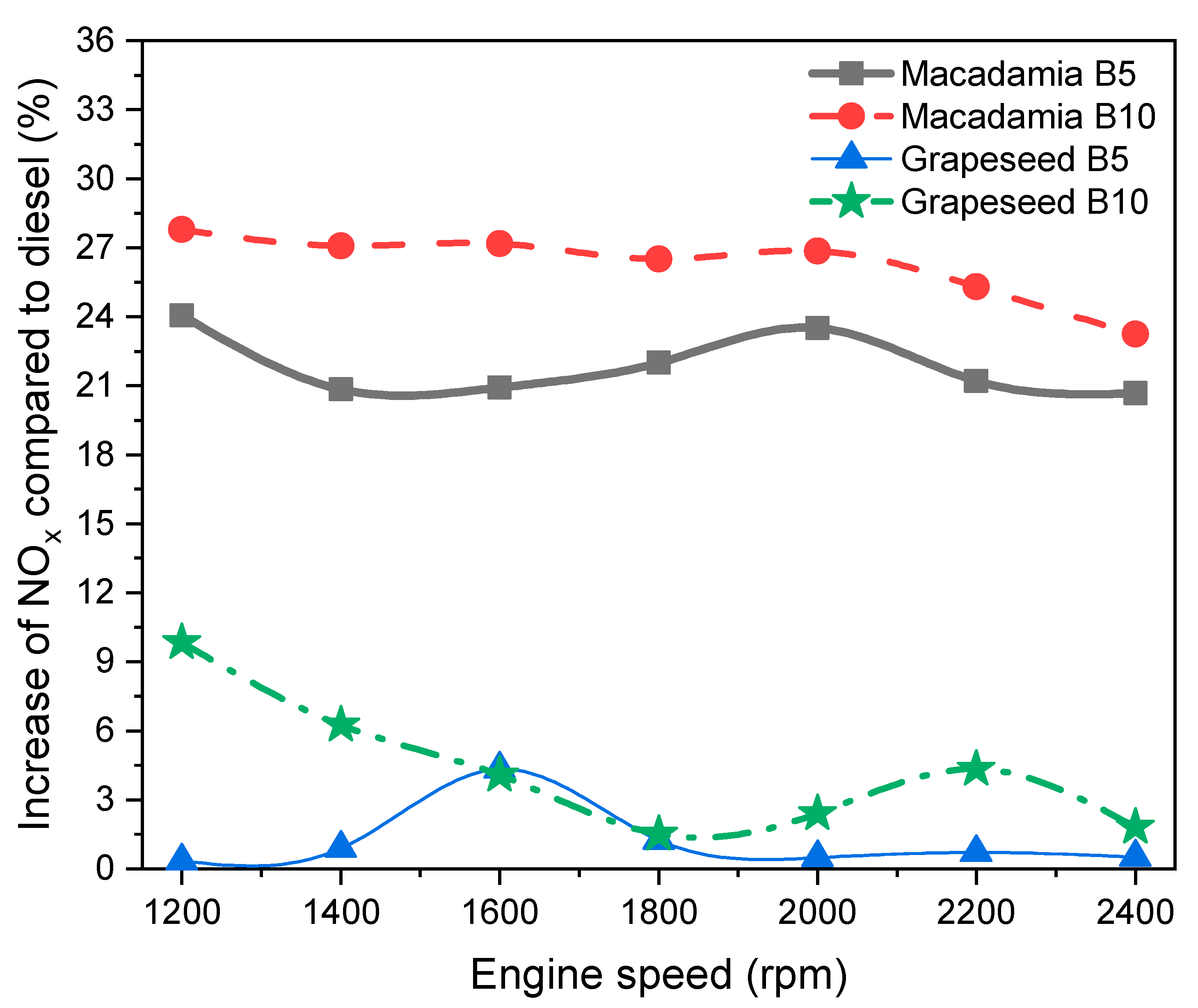
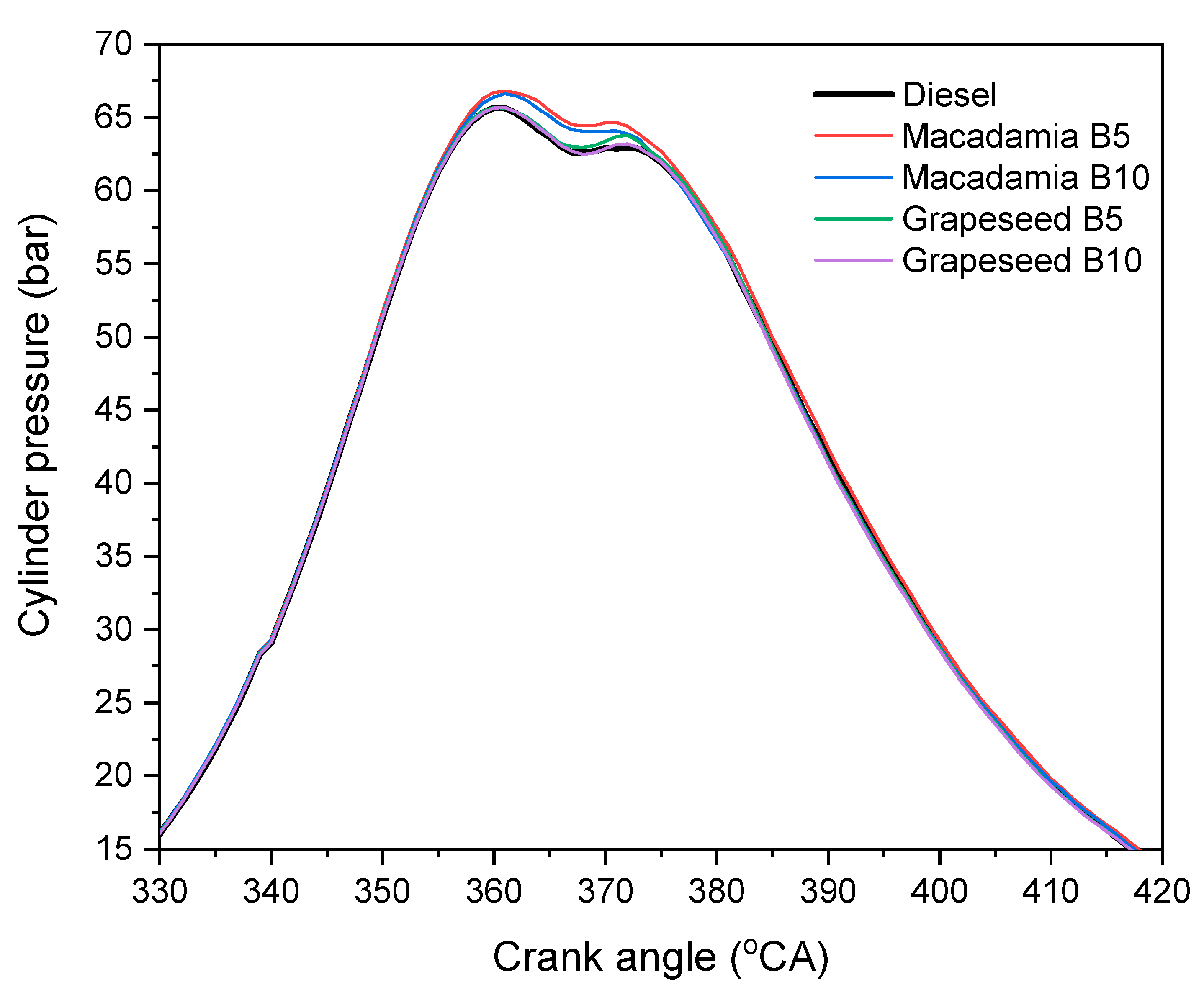

| Fatty Acid Name | Lipid | Relative Contents (% vol.) in Biodiesel | |
|---|---|---|---|
| Macadamia | Grapeseed | ||
| Lauric acid | C12:0 | 0.06 | - |
| Myristic acid | C14:0 | 0.58 | 0.2 |
| Tetradecenoic | C14:1 | - | - |
| Pentadecylic acid | C15:0 | - | - |
| Ginkgolic acid | C15:1 | - | - |
| Palmitic acid | C16:0 | 8.25 | 6.9 |
| Palmitoleic acid | C16:1 | 15.39 | 0.2 |
| Margaric acid | C17:0 | 0.03 | - |
| Ginkgolic acid | C17:1 | 0.08 | - |
| Stearic acid | C18:0 | 3.55 | 4 |
| Oleic acid | C18:1 | 61.09 | 19 |
| Linoleic acid | C18:2 | 1.86 | 69.1 |
| Linolenic acid | C18:3 | 0.11 | 0.3 |
| Arachidic acid | C20:0 | 2.94 | 0.3 |
| Eicosenoic acid | C20:1 | 2.55 | - |
| Eicosadienoic | C20:2 | 0.06 | - |
| Eicosatrienoic | C20:3 | 0.03 | - |
| Eicosapentaenoic | C20:5 | 0.97 | - |
| Behenic acid | C22:0 | 0.04 | - |
| Erucic acid | C22:1 | 0.16 | - |
| Gadolenic acid | C22:2 | 0.13 | - |
| Docosahexaenoic | C22:6 | 0.02 | - |
| Tricosylic acid | C23:0 | 0.06 | - |
| Lignoceric acid | C24:0 | 0.08 | - |
| Nervonic acid | C24:1 | 0.13 | - |
© 2020 by the authors. Licensee MDPI, Basel, Switzerland. This article is an open access article distributed under the terms and conditions of the Creative Commons Attribution (CC BY) license (http://creativecommons.org/licenses/by/4.0/).
Share and Cite
Azad, A.K.; Adhikari, J.; Halder, P.; Rasul, M.G.; Hassan, N.M.S.; Khan, M.M.K.; Naqvi, S.R.; Viswanathan, K. Performance, Emission and Combustion Characteristics of a Diesel Engine Powered by Macadamia and Grapeseed Biodiesels. Energies 2020, 13, 2748. https://doi.org/10.3390/en13112748
Azad AK, Adhikari J, Halder P, Rasul MG, Hassan NMS, Khan MMK, Naqvi SR, Viswanathan K. Performance, Emission and Combustion Characteristics of a Diesel Engine Powered by Macadamia and Grapeseed Biodiesels. Energies. 2020; 13(11):2748. https://doi.org/10.3390/en13112748
Chicago/Turabian StyleAzad, Abul Kalam, Julian Adhikari, Pobitra Halder, Mohammad G. Rasul, Nur M. S. Hassan, Mohammad M. K. Khan, Salman Raza Naqvi, and Karthickeyan Viswanathan. 2020. "Performance, Emission and Combustion Characteristics of a Diesel Engine Powered by Macadamia and Grapeseed Biodiesels" Energies 13, no. 11: 2748. https://doi.org/10.3390/en13112748
APA StyleAzad, A. K., Adhikari, J., Halder, P., Rasul, M. G., Hassan, N. M. S., Khan, M. M. K., Naqvi, S. R., & Viswanathan, K. (2020). Performance, Emission and Combustion Characteristics of a Diesel Engine Powered by Macadamia and Grapeseed Biodiesels. Energies, 13(11), 2748. https://doi.org/10.3390/en13112748










